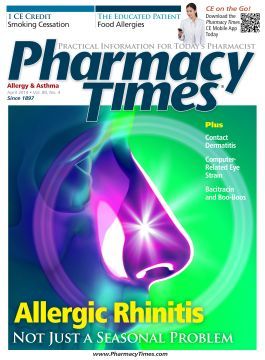Publication
Article
Pharmacy Times
Anoro Ellipta by GlaxoSmithKline and Theravance, Inc
Author(s):
The FDA has approved Anoro Ellipta (GlaxoSmithKline and Theravance, Inc) for maintenance treatment of airflow obstruction in patients with chronic obstructive pulmonary disease.
The FDA has approved Anoro Ellipta (GlaxoSmithKline and Theravance, Inc) for maintenance treatment of airflow obstruction in patients with chronic obstructive pulmonary disease (COPD). Anoro Ellipta contains umeclidinium, an anticholinergic agent, and vilanterol, a long-acting beta2- adrenergic agonist (LABA), as once-daily powders for inhalation. Anoro Ellipta is intended for long-term treatment and carries a boxed warning and important limitation that it is not intended for relieving acute bronchospasm or treating asthma.1
Pharmacology and Pharmacokinetics
Umeclidinium is a longacting antimuscarinic agent, often referred to as an anticholinergic. It inhibits the M3 receptor in the smooth muscle of the airways, resulting in site-specific bronchodilation. Vilanterol is a LABA. It exerts its effect through an increase in cyclic adenosine monophosphate, leading to relaxation of bronchial smooth muscle.
Anoro Ellipta displays linear pharmacokinetics. The pharmacokinetics of Anoro Ellipta were not shown to be affected by age, gender, inhaled corticosteroid use, weight, or race.1
Dosage and Administration
Anoro Ellipta (umeclidinium/vilanterol 62.5 mcg/25 mcg) is supplied as a powder for inhalation in an inhaler containing 2 double-foil blister strips with 30 blisters each. It should be given as 1 oral inhalation daily at about the same time each day. Anoro Ellipta should not be given more than once every 24 hours. No dosage adjustment is necessary for geriatric patients, patients with renal impairment, or patients with moderate hepatic impairment.1
Clinical Trials
The safety and efficacy of Anoro Ellipta were evaluated in dose-ranging trials and confirmatory trials. The confirmatory trials evaluated the primary end point of change from baseline in predose forced expiratory volume in 1 second (FEV1) at day 169 in patients using Anoro Ellipta compared with patients using umeclidinium alone, vilanterol alone, and placebo. The patients using Anoro Ellipta demonstrated a greater increase in mean change from baseline predose FEV1 compared with the patients using placebo, umeclidinium, and vilanterol.1,2
Contraindications, Warnings, and Precautions
Anoro Ellipta carries a boxed warning stating that LABAs, such as vilanterol, increase the risk of asthma-related death. A placebo-controlled trial with salmeterol, another LABA, showed an increase in asthma-related deaths in patients receiving salmeterol. This finding is considered a class effect of all LABAs, including vilanterol. The safety and efficacy of Anoro Ellipta has not been studied in patients with asthma, and the medication is not indicated for the treatment of asthma.
Use of Anoro Ellipta is contraindicated in patients with severe hypersensitivity to milk proteins, umeclidinium, vilanterol, or any of the components of Anoro Ellipta.
Treatment with Anoro Ellipta should not be initiated in patients with acutely deteriorating COPD or potentially life-threatening episodes of COPD. The medication should not be used as rescue treatment for the relief of acute symptoms. It should not be used in combination with another agent that contains a LABA. Use of Anoro Ellipta should be discontinued if paradoxical bronchospasm occurs. Anoro Ellipta should be used cautiously in patients with cardiovascular disorders, convulsive disorders, thyrotoxicosis, diabetes mellitus, and ketoacidosis. Worsening of narrow-arrow glaucoma or urinary retention may occur in patients with these conditions while using Anoro Ellipta. Hypokalemia and hyperglycemia may occur. Anoro Ellipta should be used cautiously when it is used concurrently with the following medications: strong CYP450 3A4 inhibitors, monoamine oxidase inhibitors, tricyclic antidepressants, beta-blockers, and diuretics. Concomitant use with anticholinergic medications should be avoided. Anoro Ellipta is Pregnancy Category C. It should not be used in women who are breast-feeding. It is not approved for use in pediatric patients.
The most common adverse reactions (≥1%) include pharyngitis, sinusitis, lower respiratory tract infection, constipation, diarrhea, pain in an extremity, muscle spasm, neck pain, and chest pain.1
Dr. Holmberg earned her PharmD from the University of Connecticut and completed an ambulatory care residency at the Phoenix VA Healthcare System. Her practice has also included pediatrics and inpatient mental health. She resides in Phoenix, Arizona.
References:
- Anoro Ellipta [package insert]. Research Triangle Park, NC: GlaxoSmithKline; 2013. http://us.gsk.com/products/assets/us_anoro_ellipta.pdf. Accessed January 2014.
- FDA approves Anoro Ellipta to treat chronic obstructive pulmonary disease. FDA website. www.fda.gov/newsevents/newsroom/pressannouncements/ucm379057.htm. Accessed January 2014.







